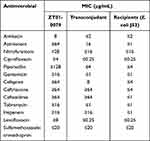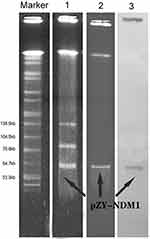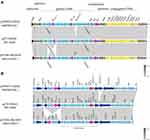Back to Journals » Infection and Drug Resistance » Volume 14
Characterization of Plasmid Co-Harboring NDM-1 and SHV-12 from a Multidrug-Resistant Citrobacter freundii Strain ZT01-0079 in China
Authors Zhang T, Lin Y, Li P, Li Z, Liu X , Li J, Li L, Wang K, Liu Z, Li P, Lu L, Wang H
Received 12 January 2021
Accepted for publication 23 February 2021
Published 9 March 2021 Volume 2021:14 Pages 947—952
DOI https://doi.org/10.2147/IDR.S301736
Checked for plagiarism Yes
Review by Single anonymous peer review
Peer reviewer comments 2
Editor who approved publication: Prof. Dr. Héctor Mora-Montes
Tingyan Zhang,1,2,* Yanfeng Lin,2,3,* Peihan Li,2,3,* Zhonghong Li,2 Xiong Liu,2 Jinhui Li,2 Lizhong Li,2 Kaiying Wang,2,3 Zhongdong Liu,1 Peng Li,2 Lanfen Lu,4 Hongyan Wang1
1School of Chemistry and Chemical Engineering, Henan University of Technology, Zhengzhou, People’s Republic of China; 2Chinese PLA Center for Disease Control and Prevention, Beijing, People’s Republic of China; 3Academy of Military Medical Sciences, Beijing, People’s Republic of China; 4Department of Laboratory Diagnosis, Sun Yat-Sen University Affiliated Zhongshan Hospital, Zhongshan, Guangdong, People’s Republic of China
*These authors contributed equally to this work
Correspondence: Peng Li; Hongyan Wang Email [email protected]; [email protected]
Background: The emergence of multidrug-resistant Citrobacter freundii poses daunting challenges to the treatment of clinical infections. The purpose of this study was to characterize the genome of a C. freundii strain with an IncX3 plasmid encoding both the blaNDM-1 and blaSHV-12 genes.
Methods: Strain ZT01-0079 was isolated from a clinical urine sample. The Vitek2 system was used for identification and antimicrobial susceptibility testing. The presence of blaNDM-1 was detected by PCR and sequencing. Conjugation experiments and Southern blotting were performed to determine the transferability of the blaNDM-1- carrying plasmid. Nanopore and Illumina sequencing were performed to better understand the genomic characteristics of the strain.
Results: Strain ZT01-0079 was identified as C. freundii, and the coexistence of blaNDM-1 and multiple drug resistance genes was confirmed. Electrophoresis and Southern blotting showed that blaNDM-1 was located on a ∼ 53kb IncX3 plasmid. The NDM-1-encoding plasmid was successfully transferred at a frequency of 1.68× 10− 3. Both the blaNDM-1 and blaSHV-12 genes were located on the self-transferable IncX3 plasmid.
Conclusion: The rapid spread of the IncX3 plasmid highlights the importance of continuous monitoring of the prevalence of NDM-1-encoding Enterobacteriaceae. Mutations of existing carbapenem resistance genes will bring formidable challenges to clinical treatment.
Keywords: C. freundii, whole-genome sequencing, genomics analysis
Background
New Delhi metallo-β-lactamase-1 (NDM-1) is an enzyme capable of hydrolyzing most β-lactam antibiotics. Since its first detection in 2009 in Klebsiella pneumoniae,1 21 NDM variants have been reported from various Enterobacteriaceae species.2–10 The increasing prevalence of NDM-producing bacteria is due primarily to intra- and inter-species exchanges of a variety of self-transferring plasmids. The coexistence of NDM and other resistance genes on a single plasmid is being reported with increasing frequency and confers high-level carbapenem resistance, which poses daunting challenges to clinical management.7,11
Citrobacter freundii, a member of the Enterobacteriaceae family, is a constituent of the commensal intestinal microbiota of animal and humans.12 However, it can cause diarrhea, sepsis,13 meningitis,14 respiratory15 and urinary tract,16 and can serve as a reservoir of antibiotic resistance genes. In recent years, due to the abuse of antibiotics, C. freundii has acquired increasing resistance to common antibiotics.17 In addition, blaNDM-1-positive C. freundii has been reported in numerous countries that including but are not limited to China,2–5 India,6,7 Japan,8 Denmark9 and South Africa.10 We report a carbapenem-resistant strain of C. freundii with coexistent blaNDM-1 and blaSHV-12 genes on a transferrable IncX3 plasmid. Antimicrobial susceptibility tests, conjugation experiments, and whole-genome sequencing were performed to study the molecular characteristics of the multidrug-resistant strain.
Methods
Bacterial Identification and Isolation
Strain ZT01-0079 was isolated from a urine sample of a patient with dysuria in 2018, in Guangzhou, China. Species identification was conducted by using the VITEK2 compact system (BioMerieux, France) and confirmed by 16S rDNA sequencing. The blaNDM gene was detected by PCR amplification as previously described.18 The isolate was obtained by conventional collection, and verbal consent was obtained as no personal information is included. All experiments were conducted in accordance with relevant regulations and approved by the Chinese PLA Center for Disease Control and Prevention.
Susceptibility Testing
The VITEK2 system (BioMérieux, France) with AST-GN09 card (bioMérieux) was used for minimum inhibitory concentrations (MICs) determinations of strain ZT01-0079 and transconjugants. The E-test method was used to determine the MIC value of meropenem. Results were interpreted in accordance with the Clinical and Laboratory Standards Institute (CLSI)19 guidelines. The following agents were tested: amikacin, aztreonam, nitrofurantoin, ciprofloxacin, piperacillin, gentamicin, cefepime, ceftriaxone, ceftazidime, tobramycin, imipenem, levofloxacin and sulfamethoxazole/trimethoprim.
S1-PFGE, Southern Blotting and Conjugation Experiment
The genomic DNA of strain ZT01-0079 was prepared in an agarose plug with S1 endonuclease (Takara, Dalian, China). PFGE separates DNA fragments by the CHEF-DR III system (Bio-Rad, Hercules, USA). PFGE runs for 15 h under the conditions of a gradient of 6.0 V/cm, a pulse time of 0.20–26.0 s and an angle of 120°. The plasmid DNA was transferred to a positively charged nylon membrane (Solabio, China) and hybridized with a digoxigenin-labeled blaNDM-1 specific probe.
Strain ZT01-0079 and Escherichia coli strain J53 were used as donors and recipients, respectively. The ZT01-0079 and J53 strains were mixed in (LB) broth at a ratio of 1:3 and incubated at 37°C for 18 h. Transconjugants were selected on MacConkey agar plates containing meropenem (4 μg/mL) and sodium azide (150 μg/mL) for 12 h. A susceptibility test was performed to determine the horizontal transferability of drug resistance, and the corresponding transconjugants were confirmed by PCR and sequencing of the NDM gene and 16s rRNA gene, S1-PFGE and southern blotting. The frequency of conjugation was calculated as the ratio of transconjugants to recipient cells.
Whole Genome Sequencing and Comparative Genome Analysis
Genomic DNA was extracted from strain ZT01-0079 using the QIAamp DNA Mini Kit (Qiagen, Hilden, Germany). Whole-genome sequencing was performed using the Illumina HiSeq 2500 sequencer in Novogene (Beijing, China), with a coverage of 109X. The nanopore sequencing library was prepared using the rapid sequencing kit SQK-RAD004 (Oxford Nanotechnology, UK). The mixed assembly of Illumina and Nanopore (Oxford Nanotechnology, UK) reads was performed using Unicycler20 (v0.4.7). PlasmidFinder21 (https://cge.cbs.dtu.dk/services/PlasmidFinder/) was used to determine the plasmid replicon type. Genotyping was performed to query the seven domesticated genes (aspC, clpX, fadD, mdh, arcA, dnaG and lysP) via the multi-locus sequence typing MLST web service22 (https://cge.cbs.dtu.dk/services/MLST/).
Nucleotide Sequence Accession Numbers23
The complete sequence of the ZT01-0079 strain and plasmids pZY-1, pZY-2 and pZY-NDM1 have been deposited in GenBank with accession numbers CP055247, CP055248, CP055249 and CP022050.
Results
Microbiological Features of Strain ZT01-0079
Strain ZT01-0079 was identified as C. freundii. Susceptibility testing showed that C. freundii ZT01-0079 exhibited resistance to aztreonam, nitrofurantoin, ciprofloxacin, piperacillin, cefepime, ceftriaxone, ceftazidime, tobramycin, levofloxacin, and imipenem (Table 1). S1-PFGE revealed that C. freundii ZT01-0079 contained three plasmids (~143kb, ~89kb and ~53kb) (Figure 1). Conjugation and southern blotting showed that the blaNDM-1 gene was located on the ~53kb plasmid and only the NDM-1-carrying plasmid was successfully transferred to J53 at a frequency of 1.69×10−3 events per donor cell. Transconjugants acquired resistance to aztreonam, piperacillin, cefepime, ceftriaxone, ceftazidime, and imipenem (Table 1). The E-test showed that strain ZT01-0079 (MIC = 8) and transconjugants (MIC = 8) are both resistant to meropenem. In silico, MLST found that C. freundii ZT01-0079 belongs to sequence type 19 (ST19). In addition to blaNDM-1, C. freundii ZT01-0079 carried multiple resistance genes including blaSHV-12, blaCTX-M-55, blaCMY-152, aph (3ʹ’)-Ib, aph (6)-Id, blaTEM-1B, sul2, floR, tet(A) and aac(3)-IId. Both the 89kb plasmid (named pZY-1) and the 143kb plasmid (named pZY-2) carried resistance genes including aph(3ʹ’)-Ib, aph(6)-Id (aminoglycoside resistance) and sul2 (sulfonamide resistance). pZY-1 also carried the blaCTX-M-55 (fluoroquinolone resistance), blaTEM-1B (cephalosporin resistance), floR (florfenicol resistance), tet(A) (tigecycline resistance) genes. pZY-2 also carried the aac(3)-IId (aminoglycoside resistance) gene, while the 53kb plasmid (named pZY-NDM1) carried the blaNDM-1 and blaSHV-12 genes (carbapenem resistance).
 |
Table 1 Antibiotic Susceptibilities of C. freundii ZT01-0079, Transconjugant and E. coli J53 (Recipient) |
Genetic Analysis of pZY-NDM1
Plasmid pZY-NDM1 is a 53573 bp circular plasmid with an average GC content of 49.24% and has 76 open reading frames. pZY-NDM1 belongs to type IncX3. BLAST comparison disclosed that the genome sequence of pZY-NDM1 shared >99% similarity with plasmids pNDM-HK3694 (Genbank accession JX104760.1) and p309074-NDM (Genbank accession MH909346.1). These three plasmids share a typical IncX plasmid backbone composed of replication (repB), plasmid stability (parA, parB), plasmid maintenance (hns, top) and type IV secretion system (taxA, taxB, taxC, VirD1, VirD2, VirD3-4, VirD5 and VirD6, VirD8, VirD9, VirD10, VirD11) encoding regions (Figure 2A). The 19.66 kb genetic load region of pZY-NDM1 located between the hns and resolvease genes, contained Tn3, IS3000, the transposon Tn125 variant encoding blaNDM-1 and a mobile element containing blaSHV-12 and ISL3. The transposon Tn125 variant served as a mobile element for the transfer of blaNDM-1 and comprised IS5, ΔISAba125, blaNDM-1, the bleomycin resistance gene ble, trpF, tat, cutA, groES and groEL as previously described.23 Compared with p309074-NDM, the pZY-NDM1 plasmid has a deletion of an 891bp ΔISAba125 fragment, which is located between IS5 and IS3000. Compared with traditional Tn125, the upstream of the pZY-NDM1 plasmid lacks ISAba125, and the downstream ISAba125 is replaced to ΔISAba125 and IS5 (Figure 2B).
The blaSHV-12-carrying transposon was located in two opposite IS26 elements and composed of ΔygbJ, ygbI and blaSHV-12. Compared with pNDM-HK3694, the blaSHV-12-carrying transposon of pZY-NDM1 was reversed. In the transposon Tn125 variant, the two ends of the blaSHV-12-carrying transposon are divided into two incomplete ΔumuD1 and ΔumuD2, which may serve as insertion sites of regions containing the blaSHV-12-carrying transposons, Tn125 variant and tnpA (Figure 2B).
Discussion
The prevalence of NDM-1-producing bacteria is receiving increasing attention as a threat to global health. Most blaNDM-1-positive isolates of diverse species of Enterobacteriaceae show high-level resistance to β-lactam antibiotics. Concurrently, the blaNDM-1 gene has also spread in many environmental and animal reservoirs, such as sewage, rivers, soil, and many mammals and poultry in Asia and the Middle East.2,9,12,24 However, reports on C. freundii are still rare. Therefore, we investigated the genomic characteristics of multidrug-resistant C. freundii (strain ZT01-0079) isolated from a clinical urine specimen. This strain has the IncX3 plasmid pZY-NDM1 that co-harbors blaNDM-1 and blaSHV-12. Plasmids belonging to the IncX3 group usually have a wide host range and self-conjugation.12,25,26 Host-range plasmids usually appear with variable frequencies ranging from 10−3 to 10−6.27 pZY-NDM1 showed a relatively high transfer frequency, proving its great potential for cross-species transfer.
The coexistence of blaNDM-1 and other β-lactamase genes in IncX3 plasmids, which have a broad host range, mediates resistance to broad-spectrum antibiotics, such as carbapenems and cephalosporins, and can be transferred between Enterobacteriaceae.28 Notably, there are few reports of such plasmids in C. freundii, and there is a potential risk of spreading this plasmid and monitoring should be strengthened.
Conclusions
In summary, we characterized the genomic basis of multidrug resistance in C. freundii ZT01-0079 strain. MLST revealed that strain ZT01-0079 belongs to ST19. ZT01-0079 carried multiple bla genes, which increased the level of carbapenem resistance. The transferable plasmid pZY-NDM1 carries blaNDM-1 and blaSHV-12 genes, and may thereby serve as a common vector for the rapid dissemination of carbapenemase-encoding genes. Our findings further underscore the threat of increased NDM-1 prevalence in Enterobacteriaceae and emphasize that increased resources and effort should be dedicated to monitoring the potentially rapid spread of NDM-1-encoding plasmids.
Data Sharing Statement
Genomic and plasmid sequences of strain ZT01-0079 were deposited in GenBank under accession CP055247, CP055248, CP055249 and CP022050.
Ethics Approval and Informed Consent
The authors state that all experimental protocols were approved by the institutional ethics committees of Academy of Military Medical Sciences.
Consent for Publication
The clinically separated samples used in this study are routine hospital procedures. We do not use patients’ personal information, so written consent is not required.
Author Contributions
All authors made substantial contributions to conception and design, acquisition of data, or analysis and interpretation of data; took part in drafting the article or revising it critically for important intellectual content; agreed to submit to the current journal; gave final approval of the version to be published; and agree to be accountable for all aspects of the work.
Funding
The study was supported by grants from the National Major Science and Technology Project (no. 2018ZX10305410), the National Key Research and Development Project (no. 2018YFC1200100) and the National Nature Science Foundation of China (no. 31900151).
Disclosure
The authors report no conflicts of interest in this work.
References
1. Yong D, Toleman MA, Giske CG, et al. Characterization of a new metallo-beta-lactamase gene, blaNDM-1, and a novel erythromycin esterase gene carried on a unique genetic structure in Klebsiella pneumoniae sequence type 14 from India. Antimicrob Agents Chemother. 2009;53(12):5046–5054. doi:10.1128/AAC.00774-09
2. Wu W, Espedido B, Feng Y, Zong Z. Citrobacter freundii carrying blaKPC-2 and blaNDM-1: characterization by whole genome sequencing. Sci Rep. 2016;6:30670. doi:10.1038/srep30670
3. Feng J, Qiu Y, Yin Z, et al. Coexistence of a novel KPC-2-encoding MDR plasmid and an NDM-1-encoding pNDM-HN380-like plasmid in a clinical isolate of Citrobacter freundii. J Antimicrob Chemother. 2015;70(11):2987–2991. doi:10.1093/jac/dkv232
4. Du XX, Wang JF, Fu Y, et al. Genetic characteristics of blaNDM-1-positive plasmid in Citrobacter freundii isolate separated from a clinical infectious patient. J Med Microbiol. 2013;62:1332–1337. doi:10.1099/jmm.0.057091-0
5. Huang YM, Zhong LL, Zhang XF, et al. NDM-1-producing Citrobacter freundii, Escherichia coli, and Acinetobacter baumannii identified from a single patient in China. Antimicrob Agents Chemother. 2015;59:5073–5077. doi:10.1128/AAC.04682-14
6. Dolejska M, Villa L, Poirel L, Nordmann P, Carattoli A. Complete sequencing of an IncHI1 plasmid encoding the carbapenemase NDM-1, the ArmA 16S RNA methylase and a resistance-nodulation-cell division/multidrug efflux pump. J Antimicrob Chemother. 2013;68:34–39. doi:10.1093/jac/dks357
7. Poirel L, Ros A, Carricajo A, et al. Extremely drug-resistant Citrobacter freundii isolate producing NDM-1 and other carbapenemases identified in a patient returning from India. Antimicrob Agents Chemother. 2011;55:447–448. doi:10.1128/AAC.01305-10
8. Nordmann P. Carbapenemase-producing Enterobacteriaceae: overview of a major public health challenge. Mdecine et Maladies Infectieuses. 2013;44(2):51–56. doi:10.1016/j.medmal.2013.11.007
9. Hammerum AM, Hansen F, Nielsen HL, et al. Use of WGS data for investigation of a long-term NDM-1-producing Citrobacter freundii outbreak and secondary in vivo spread of blaNDM-1 to Escherichia coli, Klebsiella pneumoniae and Klebsiella oxytoca. J Antimicrobial Chemother. 2016;71:3117–3124. doi:10.1093/jac/dkw289
10. Rubin JE, Peirano G, Peer AK, et al. NDM-1-producing Enterobacteriaceae from South Africa: moving towards endemicity? Diagn Microbiol Infect Dis. 2014;79(3):378–380. doi:10.1016/j.diagmicrobio.2014.04.003
11. Wu W, Feng Y, Carattoli A, Zong Z. The emergence of Enterobacter cloacae producing both KPC and NDM carbapenemases: characterization by whole genome sequencing. Antimicrob Agents Chemother. 2015;59:6625–6628. doi:10.2217/fmb-2017-0067
12. Yang L, Li P, Liang B, et al. Multidrug-resistant Citrobacter freundii ST139 co-producing NDM-1 and CMY-152 from China. Sci Rep. 2018;8(1):10653. doi:10.1038/s41598-018-28879-9
13. Pfaller MA, Jones RN, Marshall SA, et al. Inducible amp C β-lactamase producing gram-negative bacilli from blood stream infections: frequency, antimicrobial susceptibility, and molecular epidemiology in a national surveillance program (SCOPE). Diagn Microbiol Infect Dis. 1997;28:211–219. doi:10.1016/S0732-8893(97)00064-3
14. Joaquin A, Khan S, Russell N, et al. Neonatal meningitis and bilateral cerebellar abscesses due to Citrobacter freundii. Pediatr Neurosurg. 2008;17(1):23–24. doi:10.1159/000120561
15. Fujii T, Inoue Y, Sakata S, et al. Coexisting respiratory tract infection and bacteremia or sepsis caused by the same bacterium. Kansenshogaku Zasshi. 1994;68(2):217–225. doi:10.11150/kansenshogakuzasshi1970.68.217
16. Mathew JL. Antibiotic prophylaxis following urinary tract infection in children: a systematic review of randomized controlled trials. Indian Pediatr. 2010;47(7):599–605. doi:10.1007/s13312-010-0127-x
17. Bodey GP. Managing Infections in the Immunocompromised Patient. Clin Infect Dis. 2005;40(Supplement4):S239–S239. doi:10.1086/427328.
18. Zhang X, Lou D, Xu Y, et al. First identification of coexistence of blaNDM-1 and blaCMY-42 among Escherichia coli ST167 clinical isolates. BMC Microbiol. 2013;13:282. doi:10.1186/1471-2180-13-282
19. Clinical and Laboratory Standards Institute. Performance standards for antimicrobial susceptibility testing: twenty-eighth informational supplement. M100-S28. Wayne, PA, USA: CLSI; 2018.
20. Wick RR, Judd LM, Gorrie CL, Holt KE, Phillippy AM. Unicycler: resolving bacterial genome assemblies from short and long sequencing reads. PLoS Comput Biol. 2017;13(6):e1005595. doi:10.1371/journal.pcbi.1005595
21. Carattoli A, Zankari E, García-Fernández A, Larsen MV, Lund O, Villa L. In silico detection and typing of plasmids using PlasmidFinder and plasmid multilocus sequence typing. Antimicrob Agents Chemother. 2014;58(7):3895–3903. doi:10.1128/AAC.02412-14
22. Larsen MV, Cosentino S, Rasmussen S, et al. Multilocus sequence typing of total-genome-sequenced bacteria. J Clin Microbiol. 2012;50(4):1355–1361. doi:10.1128/JCM.06094-11
23. Abe R, Akeda Y, Sakamoto N, et al. Genomic characterisation of a novel plasmid carrying blaIMP-6 of carbapenem-resistant Klebsiella pneumoniae isolated in Osaka, Japan. J Glob Antimicrob Resist. 2019;21:195–199. doi:10.1016/j.jgar.2019.10.003
24. Zong Z, Zhang X. blaNDM-1-carrying Acinetobacter johnsonii detected in hospital sewage. J Antimicrob Chemother. 2013;68:1007–1010. doi:10.1093/jac/dks505
25. Ho PL, Li Z, Lo WU, et al. Identification and characterization of a novel incompatibility group X3 plasmid carrying bla NDM-1 in Enterobacteriaceae isolates with epidemiological links to multiple geographical areas in China. Emerg Microbes Infect. 2012;1(11):e39. doi:10.1038/emi.2012.37
26. Suzuki H, Yano H, Brown CJ, et al. Predicting plasmid promiscuity based on genomic signature. J Bacteriol. 2010;192(22):6045–6055. doi:10.1128/JB.00277-10
27. Grohmann E, Muth G, Espinosa M. Conjugative plasmid transfer in gram-positive bacteria. Microbiol Mol Biol Rev. 2003;67(2):277–301. doi:10.1128/mmbr.67.2.277-301
28. Tardif G, Grant RB. Transfer of plasmids from escherichia coli to pseudomonas aeruginosa: characterization of a pseudomonas aeruginosa mutant with enhanced recipient ability for enterobacterial plasmids. Antimicrob Agents Chemother. 1983;24(2):201–208. doi:10.1128/AAC.24.2.201
 © 2021 The Author(s). This work is published and licensed by Dove Medical Press Limited. The full terms of this license are available at https://www.dovepress.com/terms.php and incorporate the Creative Commons Attribution - Non Commercial (unported, v3.0) License.
By accessing the work you hereby accept the Terms. Non-commercial uses of the work are permitted without any further permission from Dove Medical Press Limited, provided the work is properly attributed. For permission for commercial use of this work, please see paragraphs 4.2 and 5 of our Terms.
© 2021 The Author(s). This work is published and licensed by Dove Medical Press Limited. The full terms of this license are available at https://www.dovepress.com/terms.php and incorporate the Creative Commons Attribution - Non Commercial (unported, v3.0) License.
By accessing the work you hereby accept the Terms. Non-commercial uses of the work are permitted without any further permission from Dove Medical Press Limited, provided the work is properly attributed. For permission for commercial use of this work, please see paragraphs 4.2 and 5 of our Terms.


